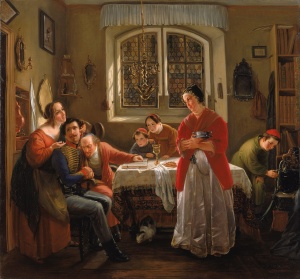Pictures Of Traditional Jewish Family Life At The Jewish Museum
For Moritz Oppenheim (1800-1882) the world had changed irreparably since his childhood in Hanau, Germany. He grew up in a devout home in the ghetto, traditionally schooled in heder and Talmud Torah until 1806, when Napoleon’s army came and brought the French Revolution to Germany. The Jews were emancipated and the ghetto gates were torn down. Moritz went to secular school and soon after distinguished himself in the Hanau Drawing Academy. His world expanded beyond the ghetto and he studied art in Frankfurt, Munich, Paris and especially Rome. By 1825 he had returned to Frankfurt to begin a successful career as a painter of Old and New Testament scenes and society portraits. As the first a major Jewish artist of the new enlightened and Romantic age, he achieved a success that for a Jew would have been unthinkable 25 years before. He became known as the painter of the Rothschilds and the portraitist of the Jewish bourgeoisie and settled into an in upper middle class life in Frankfurt.

From 1865 until the end of his life he began to depict scenes from traditional Jewish life in the family, the synagogues and the Judengasse. As he writes in his memoirs, these images were clear reflections of the world of his youth. These paintings, known as Pictures of Traditional Jewish Family Life, were soon redone as grisailles (painted in gray to accommodate easy reproduction) and made into a series of inexpensive mass produced albums that were found in almost every German Jewish 19th century home. The Jewish Museum is showing 14 of the twenty grisailles in this very important series. The Return of the Volunteer the most famous of the series, is found also in the full color original in the permanent collection upstairs on the third floor.
Oppenheim filled these paintings with late 18th century period details and costumes rendered with academic skill and set in comfortable and neat middle class interiors. They illustrate the idealized Jewish family on Shabbos. The Rabbi’s blessing and examination are lovingly depicted, as are the rites of passage of The Child enters the Covenant, The Presentation at the Synagogue, and the Bar Mitzvah Discourse. Also included are a wedding and the major holidays. While all the scenes take place in the ghetto, its narrow crowded streets are seldom depicted; a ghetto without poverty, oppression, strife or tragedy. All the paintings are staged “scenes from the life,” with picturesque local color expressing the obvious superficial emotions attached to the familiar and positive events of the Jewish life cycle.
There are some that might see these works as mere illustrations expressing a shameless sentimentality by depicting a one-dimensional dream of a pious Jewish past. Nevertheless, it is important to understand the crucial role these art works played for the majority of German Jewry who were swept by the pressures of emancipation, nationalism and 19th century modernity. Most of Germany’s Jews in the beginning of the 19th century had experiences similar to Moritz Oppenheim. Their traditional childhood and youth were swept away (or at least challenged) by a radically changed modern world. Both the Reform movement and Neo-Orthodoxy sought to become more and more German, with the solid middle class values of industriousness, discipline, and respect for tradition and family values. By emphasizing these positive values in a romanticized view of the ghetto, Oppenheim in the “Pictures of Traditional Jewish Family Life,” was able to banish the negative stereotypes of the ghetto Jew. His pictures gave the Jews, Reform and Orthodox alike, a positive and understandable Jewish identity for themselves and to their Christian neighbors. It would be intriguing to know what Rabbi Samson Raphael Hirsch though of Oppenheim’s work. They were contemporaries and Hirsch was rabbi in Frankfurt for the last thirty years of the artist’s life.
When the paintings were originally painted, they appeared with by a textual commentary by the former Reform rabbi of Frankfurt, Leopold Stein. While the didactic agenda of this series is primarily aimed at the Jews, there are numerous details that had German Christians in mind, such as the name given to his intriguing depiction of the Seder; Easter Eve! History has shown that ultimately such a strategy for Jews would lead to disaster. But, at that time in the last half of the 19th century, Oppenheim was emphasizing very real and time-honored Jewish values that, in a more nurturing context, could lead to a healthy Jewish future.
This exhibition is accompanied by an excellent and extensive catalogue of Oppenheim’s work from the Jewish Museum of Frankfurt am Main, Germany. The numerous essays on Oppenheim and Jewish identity in 19th century art in this catalogue open up the complexity of the German Jewish experience.
Moritz Daniel Oppenheim was both the quintessential man of his time and a proud Jew who tried, with his art, to rise above the tides of change in order to serve his people and preserve their precious Jewish heritage. His work and its influence is an inspiration to all who understand the important role Jewish art can play in shaping Jewish identity both then and now.
JEWISH MUSEUM
1109 Fifth Avenue, New York, N.Y.